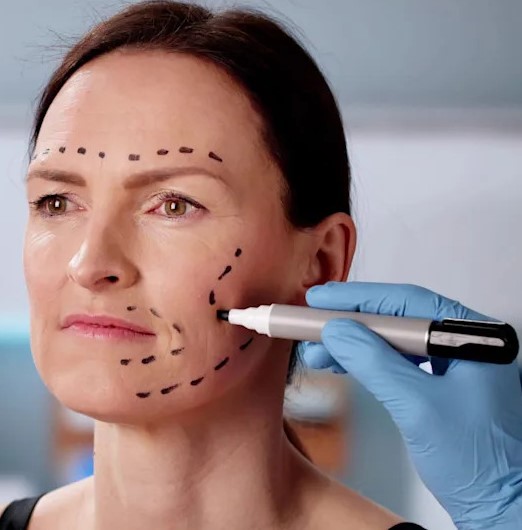- Need a Doctor for Check-up?
- 0304-4887775
- 0312-4887775

The options for facial rejuvenation have changed quickly over the years, providing individuals with several surgical options to reverse the hands of time. Today, facelift surgery in Lahore offers advanced techniques to restore youthful features and confidence. Two of the most effective methods include the deep plane facelift and the SMAS facelift. Both facial rejuvenation options provide similar benefits, including tissue lift and tightening, smoothing away wrinkles, and creating a naturally youthful contour. However, these are different techniques that vary in depth of correction, approach, and suitability for various facial shapes and ageing patterns caused by loss of elasticity.
A well-rounded surgeon like Professor Dr Mustehsan Bashir at Cosmeticoplasty focuses on making their patients familiar with the procedures and possible outcomes. He believes that understanding the different techniques is important for anyone undergoing any facial rejuvenation surgery. This article will discuss the comparison of the deep plane vs SMAS facelift, the advantages and disadvantages behind each.

As the face ages, there are several tissues that change – skin, fat, muscles and ligaments. With the loss of collagen, the skin will sag and wrinkle. However, the deeper structures, such as the SMAS layer, will lose tone and support. The SMAS is significant to facial expression and contour. As it descends with time, it leads to the obvious signs of ageing that we identify, namely jowls, nasolabial folds, and sagging cheeks.
The older techniques to address facial ageing were often replaced and only addressed the skin and leaving a very unnatural, pulled, “tight” look on the face. The techniques today focus on tightening and re-contouring beyond the skin layer. SMAS facelifts and deep plane facelifts utilize this knowledge of anatomy. They differ in the level and technique of the tissue that is manipulated in the process.
Some pros of SMAS include:
Results Appear Natural: By addressing the SMAS layer beneath the skin, surgeons are able to avoid the “windblown” look often associated with a more superficial lift.
Customized Lift: The lift can be tailored to the particular area of the face needing the lift; for instance, the jowls or the midface.
Appropriate for Mild and Moderate Ageing: It caters to patients in their 40s through early 60s who are beginning to show sagging that is visible but not yet to a high degree.
Reasonable Recovery: Recovery is about two to three weeks; thus, for many patients, it is more reasonable than other types of Facelift.
Although effective, the SMAS facelift has some minuses:
The deep plane facelift is a newer iteration of the standard SMAS lift. Rather than just folding or tightening the SMAS layer, the deep plane technique releases and repositions the SMAS layer in addition to the underlying fat pads and muscles as a unit.
This deeper technique means that the surgeon can achieve a greater lift of the midface/lower face/jawline. The deep plane facelift releases the retaining ligaments that attach the tissues underneath the skin. Moreover, it gives a more complete and natural rejuvenation compared to other facelift methods. In particular, it focuses on the area of the nasolabial folds and cheeks, which can be resistant to other facelift techniques.
Advantages of deep plane facelift are:
Comprehensive Rejuvenation: The deep plane facelift eliminates deep facial ageing by repositioning the muscle and fat layers, producing results that are more significant.
Less Skin Tension: Careful attention to tension will result in a lower chance of visible scars or skin irregularities, as the skin is not overly tight.
Sustained Results: Deep plane facelifts change the deep tissues, which can last 10 to 15 years, longer than many SMAS facelifts.
Excellent Midface Improvement: Especially beneficial for patients with droopy cheeks and deep nasolabial folds.
Natural Soft Look: Deep plane facelifts address losses in volume and contour to a patient’s natural face rather than pull tight on the skin.
Below are a few of the cons of a comprehensive facelift:
Difficult Procedure: The facelift is very technically complex and requires an experienced surgeon who possesses extensive training in the complicated dissection technique.
Longer Recovery: Recovery may take approximately three to four weeks, with the inflammation extending slightly beyond that.
Higher Cost: Given that the surgery is more complicated and longer than an SMAS facelift, a comprehensive facelift will be more expensive.
Not always necessary: For patients with mild laxity, the deep plane technique may be unnecessarily invasive.
Here is a quick overview of the two procedures:
| Feature | SMAS Facelift | Deep Plane Facelift |
|---|---|---|
| Depth of Lift addresses | The superficial SMAS layer | The area below the SMAS, freeing deeper ligaments |
| Ideal Candidates | Patients with mild to moderate facial sagging | Patients showing signs of advanced ageing or deep nasolabial folds |
| Longevity of results | Typically 7–10 years | Typically 10–15 years |
| Appearance | Natural appearance, but does not provide as much lift in the midface | Very natural appearance, restores lost volume in cheeks |
| Recovery time | Around 2–3 weeks | Around 3–4 weeks |
| Surgical complexity | Moderate | High |
| Cost | Lower | Higher |
Appropriate postoperative management is imperative for optimal results in any facelift operation. Here are some highlights that count for both procedures
Some swelling, bruising, and low-grade discomfort are usual after any facelift procedure. Pain is generally controllable with prescribed medications.
Patients should avoid tough activities, keep their head uplifted for 48 hours, and return for follow-up appointments.
Most patients of SMAS facelift return to their normal routines after 2–3 weeks, while those undergoing Deep Plane facelift procedures need up to 4 weeks to work towards full recovery.
Overall healing and the quality of your final result are highly impacted by your listening to the surgeon’s recommendations for wound care, diet, and physical activity.
Finally, the Deep Plane Facelift and SMAS facelift are both powerful methods for facial rejuvenation, with the ability to restore youthful shapes and confidence. The SMAS facelift is still a good option for those who are experiencing moderate ageing, while the deep plane facelift achieves more dramatic results that last longer with more advanced laxity of the face.
When considering these options, it’s also important to understand the facelift surgery cost in Lahore, as pricing can vary depending on the technique, surgeon’s expertise, and individual needs. In the end, the “right” option depends on your unique anatomy, ageing pattern, and expectations.
Consulting a qualified facial plastic surgeon like Professor Dr. Mustehsan Bashir at Cosmeticoplasty is the most important first step to determining the appropriate facelift technique. The surgeon’s proficiency ensures the best procedure selection to meet your desires and deliver a safe, satisfying, and natural result.
WhatsApp us